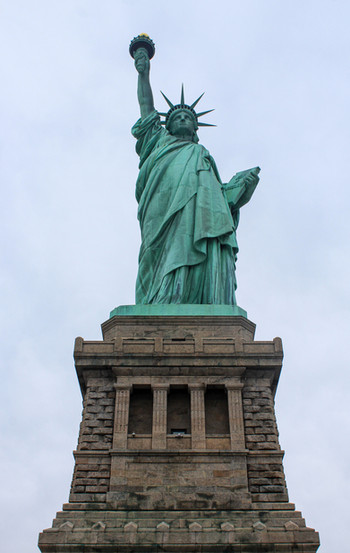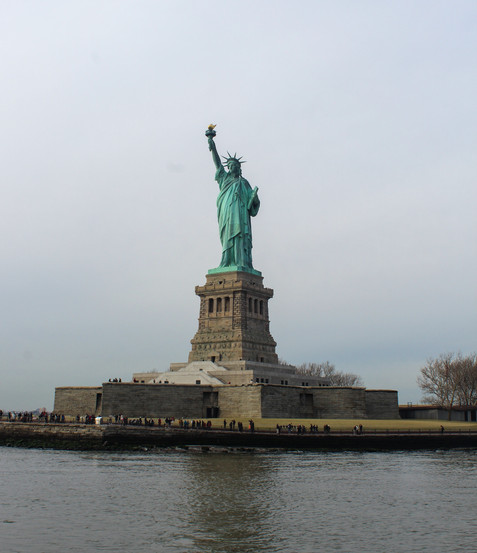The Statue of Liberty
- Tim Murphy
- Feb 13, 2021
- 11 min read
Life, Liberty, and the pursuit of Happiness. These illustrious words, synonymous with the Declaration of Independence, are emblematized by the Statue of Liberty—the symbolic guardian of our inherent freedoms and national sovereignty. Situated on Liberty Island in New York Harbor, this monumental work is an enduring example of democratic ideals and opportunity, universally appreciated by millions each year.
Akin to Ellis Island’s early history, Liberty Island was a popular fishing spot for Native American tribes prior to European colonization. When English settlers established New York in 1664, the twelve-acre isle was acquired by Captain Robert Needham. Three years later, Needham sold his property to Dutch merchant Isaac Bedloe—the island’s namesake for nearly three hundred years thereafter.
In 1738, the city of New York took possession of Bedloe’s Island and installed a quarantine station for incoming ships. A smallpox hospital and private summer residence were also constructed in the following decades. During the American Revolution, Bedloe’s Island became a sanctuary for Tory (Loyalist) refugees. In April 1776, Patriot forces raided the island, burned all the buildings, and forced the Crown sympathizers out of New York Harbor.

Between 1793 and 1796, Bedloe’s Island was maintained by the French government (with New York state approval) and resumed operations as an isolation station. However, the federal government quickly recognized Bedloe’s strategic position in New York Harbor and, in 1800, acquired the island to construct defensive fortifications.
Between 1807 and 1811, an eleven-point star-shaped fort known as the “Works on Bedloe’s Island” was constructed. During the War of 1812, the Works were renamed ‘Fort Wood’ after Colonel Eleazer D. Wood, an American officer killed at the Battle of Fort Erie. Following the war, Fort Wood was relegated to an ordnance depot and recruiting station. By the mid-1850s, the fort was nearly deserted. However, Fort Wood saw renewed purpose with the outbreak of the Civil War in 1861. The fort was regarrisoned, and while it saw no military action, it served as a prisoner-of-war camp for wounded Confederate soldiers.
The Statue’s Conception
“The American Liberty…does not hold an incendiary torch, but a beacon which enlightens.”
— Edouard de Laboulaye, 1876
In 1865, several French political activists met at a dinner party near Versailles to celebrate the Union Army’s triumphant victory over the Confederacy, commemorate the abolition of slavery in the United States, and mourn the recent assassination of President Abraham Lincoln. At the reception, Edouard de Laboulaye—a professor of political science at College de France and President of the French Anti-Slavery Society—gave a resounding speech regarding democracy and basic human freedoms. During his soliloquy, Laboulaye postulated, "Wouldn't it be wonderful if people in France gave the United States a great monument as a lasting memorial to independence and thereby showed that the French government was also dedicated to the idea of human liberty?” Laboulaye’s words astounded all in attendance, but none more so than Frederic-Auguste Bartholdi—a young sculptor who eventually realized Laboulaye’s vision.
Bartholdi had a fascination for the marvelous. For years, the artist studied the Colossus of Rhodes—an ancient Greek statue that depicted the god Helios—and longed to replicate its grandiosity. In 1867, Bartholdi designed an immense lighthouse called Egypt Carrying the Light to Asia, which depicted a robed female fellah (peasant farmer) holding a torch over the mouth of the Suez Canal. Although unexecuted, Bartholdi used this design as an inspiration to personify Laboulaye’s proposal. In 1871, Bartholdi toured the United States to promote the statue’s conception and find its ideal location. After a lengthy nationwide campaign, Bartholdi chose Bedloe’s Island as the monument’s future home.

In 1875, Bartholdi finalized his plans for the statue, which he named Liberty Enlightening the World. Laboulaye, upon approving the designs, founded the Franco-American Union (FAU) to fund Bartholdi’s project. He was appointed President upon the organization’s inception. Leading members of the FAU agreed that both France and the United States should contribute to the project’s completion. Since France was assembling the statue, America should construct its pedestal. In November 1875, Laboulaye submitted a formal request to President Ulysses S. Grant regarding the project’s stipulations and use of Bedloe’s Island as the statue’s official site. Grant approved the FAU’s proposal on his final day in office on March 3, 1877.
The Statue’s Construction
The Statue of Liberty was built in several stages between 1875 and 1884. Using a four-foot clay prototype for reference, Bartholdi and a handful of craftsmen assembled full-size plaster models for each body part. Wooden frames were then constructed around each plaster cast. Finally, using the repousse method, copper sheets were hammered inside the wood forms to create the statue’s skin. Hundreds of workers from Gaget, Gauthier & Co. tirelessly fashioned over 200,000 pounds of copper to complete this final step.
An iron framework was required to maintain the structural integrity of the statue’s skin. The original architect in charge of this was Eugene Viollet-le-Duc, who rose to prominence after restoring the Notre Dame Cathedral in the mid-1800s. Unfortunately, Viollet-le-Duc died suddenly in September 1879. In 1881, Bartholdi hired Alexandre-Gustav Eiffel—the future engineer of the Eiffel Tower—to design the support system. Eiffel devised an ingenious framework that consisted of a 96-foot central pylon surrounded by a peripheral skeleton made of cross-faced iron bars. Metal straps called ‘saddles’ were used to rivet the bars to the copper exterior. This provided firm support and reduced the mechanical burden of wind and temperature changes. Over 250,000 pounds of iron was used to construct Eiffel’s framework.
The entire statue was assembled in Paris between 1881 and 1884. Over 100,000 French citizens contributed to the statue’s realization through fundraisers and donations, raising over two million Francs (equivalent to $250,000 USD). On July 4, 1884, the Statue of Liberty was formally presented to Levi P. Morton, the U.S. Minister to France. Morton also had the honor of driving the first rivet into Liberty’s skin later that October. Unfortunately, Edouard de Laboulaye was unable to witness either of these symbolic ceremonies as he passed away in 1883. He was succeeded by Ferdinand de Lesseps—the developer of the Suez Canal—as President of the Franco-American Union.
The Pedestal
Fundraising efforts in the United States did not receive the same level of enthusiasm as their French counterparts. In fact, American citizens were largely apathetic to these campaigns, which caused significant funding delays. The first attempts to organize funds were spearheaded by the Union League of New York in 1876. However, potential contributors were reluctant to donate for several reasons. Some viewed the statue as an endowment to New York, not the nation, while others questioned why they needed to contribute money when it was technically a “gift” from France. Additionally, there was an overwhelming consensus that the statue would not be completed at all. In an effort to quell the skepticism, the Union League exhibited the statue’s right arm and torch at the 1876 Centennial Exposition in Philadelphia. While the spectacle drew large crowds, it did little to advance pedestal fundraising.
In January 1877, several prominent benefactors organized the American Committee for the Statue of Liberty. William Maxwell Evarts—at the time, a former U.S. Attorney General and future Secretary of State—was elected Chair of the Committee. Evarts was a persuasive statesman and exercised his influence on Congress to gain legislative and financial support for the statue. In addition to his political efforts, Evarts was steadfast in the Committee’s fundraising programs, helping raise $125,000 between 1877 and 1884.
In 1881, the American Committee appointed architect Richard Morris Hunt to design the statue’s pedestal. Upon consulting the Committee’s chief engineer, General Charles P. Stone, Hunt decided to incorporate the walls of Fort Wood into the pedestal’s foundation; however, this ambitious endeavor required several years of intense planning to achieve perfection. In 1883, while Hunt finalized his drafts, Stone excavated the fort’s foundation and poured nearly twenty feet of concrete within the void, creating a solid groundwork for the future monument.

On August 5, 1884, construction for the pedestal officially commenced. Unfortunately, within a few months of work, the American Committee exhausted its funds. Henry F. Spaulding, the Committee’s Treasurer, estimated that an additional $100,000 was needed to complete the pedestal. If unable to raise the necessary funds, the project would have to be abandoned. The statue’s fulfillment hung in a state of uncertainty as the Committee desperately tried to accrue contributions.
On March 15, 1885, Joseph Pulitzer, owner and editor of the New York World, published a front-page fundraising drive for the statue’s completion. Pulitzer wrote:
“We must raise the money! The World is the people's paper, and now it appeals to the people to come
forward and raise the money. The $250,000 that the making of the Statue cost was paid in by the masses
of the French people- by the working men, the tradesmen, the shop girls, the artisans- by all, irrespective of
class or condition. Let us respond in like manner. Let us not wait for the millionaires to give us this money.
It is not a gift from the millionaires of France to the millionaires of America, but a gift of the whole people
of France to the whole people of America.”
The sensationalism of Pulitzer’s plea evoked a nationwide response. Over the course of five months, 120,000 individuals donated a collective $102,000. In response to the overwhelming support, Pulitzer printed each donor’s name in the World, thanking them on behalf of the nation.
Pedestal construction resumed in May 1885; however, it was far from complete when the Statue of Liberty arrived on the French steamer Isere on June 17, 1885. An additional ten months were required to finish the pedestal. During that time, the statue laid disassembled in crates across New York Harbor. On April 22, 1886, following the pedestal’s completion, the statue’s reassembly commenced. Remarkably, this final stage was accomplished in just under six months.
The Grand Unveiling
“We will not forget the Liberty has here made her home…[Her] light shall pierce the darkness of ignorance and man’s oppression until liberty enlightens the world.”
— President Grover Cleveland, October 28, 1886
The Statue of Liberty was formally unveiled to the public on October 28, 1886. Despite the steady rain and dense fog, over one million people attended the celebration across the city. At the time of its unveiling, the Statue of Liberty was the tallest building in New York, towering 305 feet above the ground.
The unveiling ceremony featured several keynote speakers, including U.S. President Grover Cleveland, FAU President Ferdinand de Lesseps, and American Committee Chairman William Maxwell Evarts. Bartholdi was offered a chance to speak publicly, but he declined. Instead, the sculptor sat upon the head of the statue, ready to reveal its face at the end of Evarts’s speech. In what can only be described as an epic miscue, Bartholdi mistook a prolonged pause in Evarts’s oration as his finale and pulled the French flag off the statue’s face. Although Evart was not finished with his speech, he humbly sat back down as the crowds erupted with cheers and cannons fired in salute.
Liberty’s Significance and Interpretation
The Statue of Liberty was intended to be a symbol of democracy, independence, and the triumph of freedom over oppression. The statue is emblematic in its own right, but Bartholdi masterfully incorporated more subtle pieces of symbolism in his finished product. He fashioned the statue in the likeness of Libertas—the Roman goddess of liberty—who was revered by freed slaves of the ancient Roman Empire. Her seven-point crown represents rays of enlightenment, while her torch beckons truth and progress. In her left arm, she carries a tablet inscribed with “JULY IV MDCCLXXVI” (July 4, 1776), the date commemorating American independence. At her feet lie broken shackles, signifying the liberation from tyranny and recent emancipation of slaves.
For many African Americans, the Statue of Liberty—while striking in its appearance—epitomized America’s harsh realities and hypocritical values. The abolition of slavery did not erase the sinister legacies of racism and discrimination as African Americans across the United States were continually denied equal rights. In the absence of “liberty and justice for all,” the statue romanticized American independence and perpetuated a false narrative ignorant of the atrocities regularly inflicted upon black individuals.

Women’s suffragists also took issue with the statue’s ironic symbolism. Liberty was depicted as a female, yet women were granted far fewer opportunities than men, specifically the right to vote. Additionally, women were prohibited from celebrating the statue’s unveiling on Bedloe’s Island (with the exception of Bartholdi’s wife, Jeanne-Emilie, and Ferdinand de Lesseps’s granddaughter). Suffragists protested this sexist barring aboard ships around the harbor, but their demonstrations were drowned out and largely ignored by the huddled masses.
As an icon of American freedom, the Statue of Liberty was seen as a welcoming symbol of opportunity for many immigrants who arrived in New York Harbor. She greeted over fourteen million immigrants between 1886 and 1924 and became known as the “Mother of Exiles”—a term coined by Emma Lazarus in her poem “The New Colossus.” In 1883, Lazarus worked as an aide for Jewish immigrants detained at Castle Clinton and was inspired by their tenacity amidst their plights. She penned “The New Colossus” to raise money for Liberty’s pedestal in honor of their memory. In 1903, Lazarus’s words were immortalized in bronze and fastened to the pedestal’s interior for all to behold.
Lady Liberty’s Legacy
After its dedication, the Statue of Liberty was operated by the U.S. Lighthouse Board, since it was considered a federal lighthouse as opposed to a national monument. However, when Liberty’s torch was lit, it produced only a faint glow that was barely visible across New York Harbor. After an underwhelming tenure as a lighthouse, the Statue of Liberty was acquired by the War Department, which operated the still-active army post at Fort Wood.
On July 30, 1916, the Statue of Liberty suffered extensive damages due to the Black Tom Explosion. Nearly $100,000 was spent on repairs across Bedloe’s Island. Public access to Liberty’s torch was prohibited and remains off-limits to this day. During World War I, the statue became a unifying symbol for the American war effort. The monument was frequently featured on posters advertising “Liberty Bonds”—war bonds used to help finance America’s participation in the global conflict.
In 1924, President Calvin Coolidge declared Fort Wood and the Statue of Liberty national monuments. They were placed under the authority of the National Park Service (NPS) in 1933. Four years later, the War Department relinquished the rest of Bedloe’s Island to the NPS. With total jurisdiction, the NPS hired landscape architect Norman Newton to transform Bedloe’s Island into a manicured national park. Newton requisitioned the services of the Works Progress Administration (WPA) to demolish old army buildings around the island and install walkways and gardens in their place.
The beautification and restoration projects continued on the island until the U.S. entered World War II in December 1941. From 1942 to 1945, Liberty’s flame was extinguished due to wartime blackout regulations. In 1948, Congress appropriated an additional $110,000 towards the resumption of public works around the island. In 1956, Bedloe’s Island was officially renamed Liberty Island.

In 1984, the Statue of Liberty was named a UNESCO World Heritage Site for its “[endurance] as a highly potent symbol—inspiring contemplation, debate, and protest—of ideals such as liberty, peace, human rights, abolition of slavery, democracy and opportunity." Also during this time, American steel workers refabricated the interior iron frameworks with stainless steel, as years of corrosion and oxidation weakened their structural stability. Liberty’s torch was replaced as well. The restorations were completed in time for the statue’s centennial celebration on July 4, 1986.
Liberty Island closed to the public following the terror attacks that occurred on September 11, 2001. While the island reopened later that year, visitors were still prohibited from entering the statue. The pedestal reopened in 2004, but due to safety concerns, access to the statue itself was restricted until 2009. In October 2016, construction crews broke ground for the new, seventy-million-dollar Statue of Liberty Museum, which opened May 16, 2019.
Liberty Island may only be accessed by ferry services that depart from Liberty State Park, New Jersey, and Battery Park, Manhattan. Ferry tickets—which include access to Ellis Island and the statue’s pedestal—cost around $20 for adults. For an extra $3, tourists have the opportunity to ascend to the statue’s crown; however, this experience is extremely limited, and many people reserve their tickets up to a year in advance.
After docking, visitors may walk along the island’s peripheral promenade to the pedestal entrance. Once inside, tourists can climb six stories to the top of the pedestal and be greeted with stunning views of New York City and the harbor. At the northern end of the island is the Statue of Liberty Museum. Formerly housed in the statue’s pedestal, this fascinating facility contains several exhibits that describe the monument’s conception, construction, and lasting legacy. On display are some antique statue Americana, a life-sized casting of Liberty’s left foot, and the original torch designed by Bartholdi.
The Statue of Liberty is one of America’s most treasured landmarks—a unifying symbol and idealization of democracy. She represents not only egalitarian ideals, but the advancement of society. Liberty progresses with changing times and beckons us to continuously foster a culture of inclusion, so that our nation’s democratic freedoms may be extended to all Americans.
For more information on the Statue of Liberty, check out the following resources:
Read these publications for more information on the statue's history:
Moreno, Barry. The Statue of Liberty. Arcadia Publishing, 2017.
“NPS Historical Handbook: Statue of Liberty.” National Parks Service. U.S. Department of the Interior, 1954.























